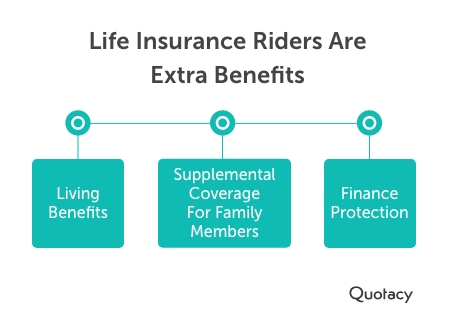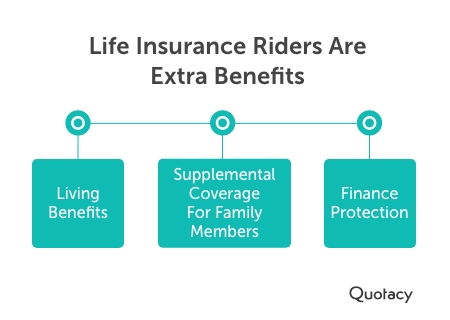What is an insurance rider? It is an additional benefit on top of your standalone policy’s benefits. There are actually many types of riders in insurance. These optional add-ons help customize your coverage to meet all your needs.
While there are many rider options, not all of them will make sense for you to add on. Here we’ll dig into some of the most common life insurance policy riders and why they matter.
Explore policy options and learn the difference between term and permanent life insurance.
What Is a Life Insurance Rider? Why Is it Important?
The main purpose of life insurance is income replacement for your loved ones if you pass away unexpectedly.
Riders are extra benefits you can add to a policy to bolster and customize coverage. Different riders offer different benefits.


What Are the Different Riders in Life Insurance?
Available options vary by insurance company, but we’re going to explore the most common.
To keep things simple, we will break them into two categories:
Living benefits:
- Accelerated Death Benefit Rider
- Disability Income Rider
- Long-Term-Care Rider
- Chronic Illness Rider
- Critical Illness Rider
Family & financial protection:
- Accidental Death and Dismemberment Rider
- Child Rider
- Spousal Rider
- Term Conversion Rider
- Waiver of Premium Rider
- Return of Premium Rider
- Unemployment Protection Rider
- Guaranteed Insurability Rider
- Guaranteed Renewability Rider
Living Benefit Riders
We will start with riders categorized as “living benefits”. They are referred to as such because they provide benefits while you’re still alive. Living benefits are unique because life insurance policies typically don’t pay benefits while the insured person is still alive.
Accelerated Death Benefit Rider
An accelerated death benefit rider gives you access to some amount of your policy’s death benefit if you are diagnosed with a terminal illness.
This life insurance policy rider is included for free on most policies.
Accelerated death benefit riders:
- Free and usually automatically included
- Let you use a portion of your policy if you’re diagnosed with a terminal illness
- Living benefit
Disability Income Rider
The disability income rider provides a supplementary income if you become disabled.
Your policy’s coverage amount determines your supplementary income. Most insurance companies limit how much you’ll collect and how long.
The cost of a disability income rider varies based on your age, health, occupation, hobbies, and the benefits you choose.
Work with an insurance broker to compare the pros and cons of adding this disability rider to your policy vs buying an individual disability insurance policy.
What to know about disability income riders:
- Cost based on your age, health, lifestyle, and benefits chosen
- Pays supplemental income if you become disabled
- Living benefit
Long-Term Care Rider
A long-term care rider pays out money tax-free from your policy’s death benefit to pay for your long-term care if you cannot perform 2 out of 6 activities of daily living (ADLs) for at least 90 days. Your condition doesn’t need to be permanent.
If you never use the LTC rider benefits, your beneficiaries collect the total death benefit amount when you die. If you access the rider benefits, your beneficiaries receive the death benefit minus the long-term care accelerated benefits used.
It’s one of the more costly riders but far less expensive than a long-term care insurance policy.
Long-term care rider highlights:
- Cost based on your age, health, lifestyle, and benefits chosen
- Pays out from your policy’s death benefit for permanent or temporary long-term care needs
- Only available on permanent life insurance policies
- Living benefit
Chronic Illness Rider
A chronic illness rider is similar to LTC in that it pays out benefits if you’re no longer able to perform 2 out of 6 activities of daily living. It’s another type of living benefits rider. To get benefits, you’ll need doctor confirmation that your condition is permanent.
Any benefits you use while alive will reduce the death benefit payout your beneficiaries collect when you die.
Chronic illness rider:
- Cost based on your age, health, lifestyle, and benefits chosen
- Pays out from your death benefit if diagnosed with a permanent chronic medical condition
- Living benefit
Critical Illness Rider
The critical illness rider. let’s you get money from your policy’s death benefit if you’re diagnosed with a critical illness. Eligible illnesses vary by company but generally include cancer, heart attack, stroke, kidney failure, vital organ transplant, and paralysis.
Any benefits you use while alive will reduce the death benefit payout your beneficiaries receive when you die.
Critical illness rider:
- Cost based on your age, health, lifestyle, and benefits chosen
- Pays out from your policy’s death benefit if diagnosed with a critical illness
- Living benefit
Riders for Family & Financial Protection
This next group of policy riders offer supplemental coverage for family members and additional financial protection.
Accidental Death and Dismemberment Rider
With an accidental death and dismemberment (AD&D) rider, your life insurance policy beneficiary will receive an increased death benefit if you die due to an accident.
If you lose a limb or your sight in an accident, the rider also pays out your benefit.
The cost of this insurance rider varies by age and the benefit amount you choose. Your occupation and hobbies also impact your eligibility for this rider and how much it will cost.
What you should know about AD&D riders:
- Cost based on your age, occupation, and benefit amount chosen
- Pays beneficiaries extra if you die due to an accident
- Pays you a benefit if you are dismembered in an accident
Child Rider
If you have kids, a child rider is one of the most critical options available. It provides a few thousand dollars of life insurance coverage for your children under 18.
This rider is essential for the what-ifs. What if the worst should happen and you outlive your child? What if your child becomes uninsurable for traditional life insurance?
In addition to being insured while growing up, the child rider provides guaranteed future insurability. It can be converted into a small permanent life insurance policy they eventually own or you continue to hold. If the rider is not converted, coverage ends when the child reaches the policy’s age of maturation – 18, 22, or 25 years old, depending on the policy.
The price of this rider is minimal. For an extra $50 per year, all of your children are covered by one child rider. If you have more children in the future, you can easily add them.
All parents should consider a child rider because:
- Cost is minimal, ~$50/yr
- Pays a death benefit if your child dies
- One rider covers all your children
- Provides guaranteed future insurability up to a certain age
- Convertible to a permanent policy until your child reaches the age of maturation
Spousal Rider
A spousal rider works similarly to a child rider. It provides limited life insurance for your spouse when added to your life insurance policy.
If the policy owner dies, the rider terminates, and the surviving spouse loses that coverage. This isn’t ideal if you have children. Both parents should have life insurance policies.
Spousal riders are becoming less common due to how affordable term life insurance is in comparison.
What to know about a spousal rider:
- Rider cost is based on your spouse’s health
- Pays a death benefit if your spouse dies before you
Term Conversion Rider
A term conversion rider allows you to convert all or some of your term life insurance policy into a permanent life insurance policy. Most term policies include this rider for free.
This term rider’s main benefit is the guaranteed insurability factor. If you buy term life insurance and later decide you want lifelong coverage, you can buy a new permanent policy. It’s important to note you’ll go through underwriting again.
- Provides guaranteed insurability
- Free and usually automatically included
- Converts your term policy into a permanent policy without evidence of insurability
Waiver of Premium Rider
A waiver of premium rider allows you to skip paying your life insurance policy’s premiums if you become disabled and cannot earn an income. Your coverage will remain active during this time. Once you start working again, the skipped premiums will not need to be paid back.
To qualify, the illness or disability must prevent you from working for a continuous period—around six months. The insurance company requires medical proof.
The cost of a waiver of premium rider varies based on your age, health, occupation, and hobbies. If your lifestyle increases your risk of disability (e.g., you’re an avid mountain climber), the cost of the rider will be higher. The rider may be unavailable depending on your level of risk.
Waiver of premium rider highlights include:
- Cost based on your age, health, and occupation/avocations
- Pays for your life insurance policy if you become disabled and can’t work
- No repayment for premiums waived while you’re disabled
See what you’d pay for life insurance
Return of Premium Rider
A return of premium rider makes you eligible for a refund of your premiums if you outlive your term life insurance policy.
Getting your money back comes with a price. Consider the example below.
A 35-year-old male can buy a $500,000 20-year term life insurance policy at Preferred Best rates for $28.60 per month.
This same person also can buy a $500,000 20-year return of premium term life insurance policy at Preferred Best rates for $101.64 per month.
In this person’s case, the difference between a term policy with and without a return of premium rider is $73.04 per month.
Some like the feeling of a guaranteed payout no matter what. Others prefer to take that $73.04 per month and invest it.
What to know about return of premium riders:
- Cost determined by your base policy’s cost
- Increases your overall monthly premium significantly
- Refunds your paid premiums if you outlive your term policy
- No refund if you cancel your term policy
Unemployment Protection Rider
An unemployment protection rider ensures that you would not need to pay your life insurance policy premiums if you involuntarily lose your job.
You must prove that you’ve gotten government unemployment benefits for four continuous weeks before benefits begin.
Unemployment protection rider:
- Is an extra cost on top of your base policy
- Pays your policy premiums if you become unemployed
Guaranteed Insurability Rider
The guaranteed insurability (GI) rider lets you buy more insurance in the future without going through an exam or answering health questions.
This rider is available for both term and permanent life insurance. But note that this rider can only increase the coverage amount, not the term length.
There is a cost to add this rider. It may be worth it if you have a family history of medical issues or think your health may change significantly.
GI rider highlights:
- Is an extra cost on top of your base policy
- Allows you to increase your death benefit without underwriting
- Your premiums will increase due to the increased coverage
Guaranteed Renewability Rider
With a guaranteed renewability rider, you can renew your term coverage without going through underwriting again. Most term policies include this rider for free.
The renewal premiums are costly and increase each year you renew. It’s only beneficial if you become terminally ill and need to keep your coverage for your family’s benefit.
What to know about the guaranteed renewability rider:
- Free and automatically included
- Allows you to continue your term coverage without proof of insurability
- Renewal premiums are expensive and will increase each year you renew
Explore different life insurance policy options and their average monthly costs.
Get a Life Insurance Quote to Find Your Policy Rider Options
Talk to your agent about policy riders when you apply for life insurance.
Most riders need to be added before your policy coverage begins. However, if you opt-in, you can drop them anytime without penalty.
Life insurance riders can be an inexpensive way to cover additional needs. But they aren’t always worth the extra cost. Contact the experts at Quotacy to learn more about your policy rider options today.
Learn how to determine what you need and how to buy life insurance.


0 Comments